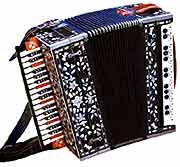 |
Garmon
decorated with
mother-of-pearl
V.Gafarov's
private collection.
Shamakhi. 1988 |
The
garmon is a keyed wind instrument with bellows and
free metal reeds (photo 23). It first became a part
of Azerbaijani traditional musical culture at the
end of the 19th century.
Nowadays
it is a popular part of Azerbaijan's musical culture.
The garmon is used in various ensembles and has found
wide application in dance music. It's no surprise
that the modern version of the garmon is very often
considered to be Azerbaijan's national instrument.
The
garmon is a rectangular box, the lateral parts of
which are made of wood, with leather bellows in the
middle part. The height of the instrument is 360 mm,
and the width is 268 mm. Thin metal keys are located
in an internal part of the box, on wooden plates in
a certain order.
By
stretching and compressing the bellows with both hands,
while pressing the keys, the pfayer causes the compressed
air to pass through the space formed. The fingers
of the right hand play the melody, and the fingers
of the left hand hold the tonic of the appropriate
key. Thus, depending on the size of the vibrating
plates, the performer produces sounds of various pitches.
The garmon has an attractive timbre. Its range goes
from the "do" of the small octave to the
"fa" of the third octave. The technical
performance properties and sound structure of the
Azerbaijani Pgarmon with its chromatic scale is different
from those of the Russian garmons. Instrument makers
who w:jived in Azerbaijan developed its sound system
in complete conformity with the Azerbaijani musical
\scale. Besides this aspect, the timbre and color
of the instrument and its wide technical and performance
opportunities make it a very convenient instrument
for performing Azerbaijani national music, including
mughams.
|